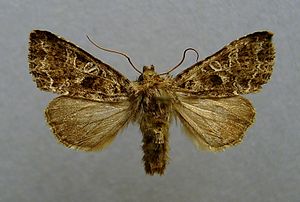Light carnation owl
| Light carnation owl | ||||||||||||
|---|---|---|---|---|---|---|---|---|---|---|---|---|

Light carnation owl ( Hadena bicruris ) |
||||||||||||
| Systematics | ||||||||||||
|
||||||||||||
| Scientific name | ||||||||||||
| Hadena bicruris | ||||||||||||
| ( Hufnagel , 1766) |
The light carnation owl ( Hadena bicruris ) or common capsule owl is a butterfly ( moth ) from the family of the owl butterflies (Noctuidae).
features
butterfly
The wingspan of the moth is 33 to 40 millimeters. The basic color of the forewings varies from gray-brown to black-brown. Ring and kidney defects have a whitish border and do not touch, but occasionally come closer. The wavy line also stands out whitish. Characteristic is a black spot on the inner edge of the forewings below the ring flaws. The hind wings are solid gray-brown.
Caterpillar
Adult caterpillars are brownish in color and show a light topline as well as dark angular spots on the back segments.
Similar species
- Hadena capsincola has only been listedas an independent speciessince 1996 after the genus Hadena was revisedby hackers. While bicruris is mostly native to Western Europe, capsincola occursin eastern regions. It is usually a little darker in color. However, a genital morphological examination should be carried out to differentiate reliably.
- The catchy clove owl ( Hadena perplexa ) differs mainly in the absence of the blackish spot on the inner edge of the forewings below the ring blemish. On the other hand, black arrow marks can be seen on the wavy line. The moths are usually smaller than those of bicruris .
Geographical distribution and habitat
The species is classified as widespread atlanto-Mediterranean. Preferred habitat are dry roadsides, warm slopes and embankments, quarries, weed corridors as well as gardens and parks. In the Alps, it rises to around 2000 meters.
Way of life
The moths are crepuscular and nocturnal, like to suckle on the flowers of various carnation plants ( Caryophyllaceae ), but also visit bait and artificial light sources . The main flight time is from May to July. Sometimes a second generation forms in late summer. Female moths only lay one egg at a time in the flower of a forage plant. The caterpillars then feed mainly on the seed pods of red light carnation ( Silene dioica ), white light carnation ( Silene latifolia ) and pigeon goiter ( Silene vulgaris ). The species overwinters as a pupa .
Danger
The light carnation owl occurs in Germany in different frequencies and is classified as not endangered on the Red List of Endangered Species , but in Baden-Württemberg on the warning list.
swell
Individual evidence
- ↑ a b Hermann Hacker, László Ronkay, Márton Hreblay: Hadeninae I . In: Michael Fibiger, David Agassiz, Martin Honey (Eds.): Noctuidae Europaeae . tape 4 . Entomological Press, Sorø 2002, ISBN 87-89430-07-7 (English).
- ↑ a b c Günter Ebert (Ed.): The butterflies of Baden-Württemberg . 1st edition. tape 7 . Moth V Noctuidae 3rd part. Ulmer, Stuttgart (Hohenheim) 1998, ISBN 3-8001-3500-0 .
- ↑ Walter Forster , Theodor A. Wohlfahrt : The butterflies of Central Europe. Volume 4: Owls. (Noctuidae). Franckh'sche Verlagshandlung, Stuttgart 1971, ISBN 3-440-03752-5 .
- ↑ Federal Agency for Nature Conservation (Ed.): Red List of Endangered Animals in Germany . Landwirtschaftsverlag, Münster 1998, ISBN 3-89624-110-9 .
literature
- Günter Ebert (Ed.): The butterflies of Baden-Württemberg . 1st edition. tape 7 . Moth V Noctuidae 3rd part. Ulmer, Stuttgart (Hohenheim) 1998, ISBN 3-8001-3500-0 .
- Hermann Hacker, László Ronkay, Márton Hreblay: Hadeninae I . In: Michael Fibiger, David Agassiz, Martin Honey (Eds.): Noctuidae Europaeae . tape 4 . Entomological Press, Sorø 2002, ISBN 87-89430-07-7 (English).
Web links
- Lepiforum eV taxonomy and photos
- www.schmetterlinge-deutschlands.de Endangerment
- Hadena bicruris at Fauna Europaea